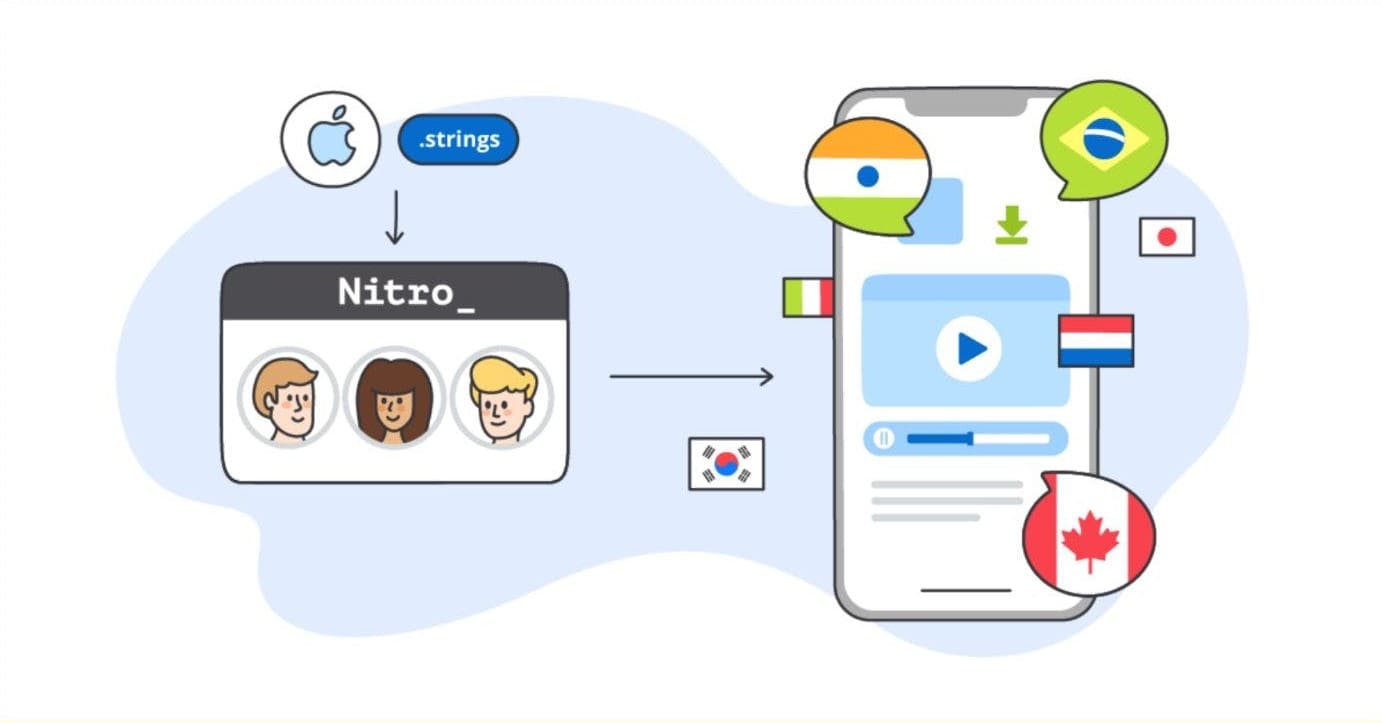If you're planning to enter a new market or expand it this year but have doubts about which languages to pick for localization to boost your product's growth, we think this article will help you ;-)
In this article, we wanted to share with you some eye-catching facts and conclusions, like which language pairs were the most popular in games, mobile apps, e-commerce, and other domains.
Every year on our Nitro platform, we perform in-house research to analyze the results of the previous year and see what's happening in the translation and localization market. Nitro by Alconost is a human translation platform where all translations are done by native-speaking linguists within 24 hours. There's no machine translation involved. Let's see what our language research has to say!
The Top 10 languages requested for translation in 2022
The research is based on Nitro's 2022 client order database and shows target language popularity in Nitro in general and by various domains. This helps us reflect on trends in the translation market.
The results of this research indicates that the European group of languages remains on top, while Asian languages saw an expected rise in popularity. Learn more about these trends below.
German, French, and Spanish remain among the leaders on Nitro's chart of year-to-year changes in languages' popularity. There's a specific reason behind this persistent stability: translating into one of these languages simultaneously covers several countries.
Here's our Top 10 list of the most popular languages for translation in 2022:
- German
- French
- Spanish
- Japanese
- Italian
- Chinese (Simplified)
- Korean
- Portuguese (Brazil)
- Turkish
- Indonesian
.png?width=2820&height=1736&name=image-1%20(1).png)
*The diagram above is based on Nitro's 2022 client order database.
German covers Germany, Austria, Liechtenstein, Switzerland, Luxembourg, and Belgium. French includes France, Belgium, and Switzerland and is also widespread in many African countries.
By translating to Spanish, you'll reach Spain, Andorra, South America, Central America, the Caribbean, and some countries in North America. And don't miss your chance to think about other languages in our Top 10 list: Italian, Portuguese, Turkish, and Danish.
The Asian market's data-proven potential
Diana, Product Manager @ Nitro by Alconost:
"Here's an insight: based on our in-house research, the Asian language sector is constantly moving up in popularity among the target languages ordered. This year, it captured 50% of our Top 10 languages by order popularity, and I predict that it will be even higher next year."
In the last few years, the languages of Asian countries — primarily Japanese, Chinese, and Korean — are experiencing the ever-growing potential to become a new must-have for localization. In addition to that, in 2022, Indonesian, Thai, and Vietnamese have already entered our Top 10, as well. Why is that? Asia is a real plum for app developers, especially in the mobile gaming sector, and it's also well known for its highly developed video game industry. So, if you're in search of new markets to grow the audience of your RPG, hyper-casual, or eSports games, you should definitely consider these languages for localization and support.
As for the mobile market, make sure you've considered translating your app into one of these Asian languages if your product deals with shopping, second-hand marketplaces, food delivery, finance, streaming services, photo and video editors, or productivity. South Korea is also showing a growing interest in apps for health & fitness and education, such as apps for learning foreign languages.
Given that the Asian market continues its trend of dynamic growth, the only question is how to get on board while it's still not too late.
The top languages for translation in 2022 by business sector
Below, we've gathered some insights about the most popular languages for translation for apps, software, games, and marketing needs. We'll also share some tips on how to navigate the unique features of localization for each industry based on our experience.
Apps and software
In 2022, various apps and software were translated into 83 languages on Nitro. Of these, the following language pairs were the most popular (Top 5):
- Italian
- French
- Japanese
- Portuguese (Brazil)
- Dutch
%20(1).png?width=955&height=588&name=image-3%20(1)%20(1).png)
*The diagram above is based on Nitro's 2022 client order database.
Apart from considering the Top 5 language pairs from above, you may want to consider getting your app internationalized to facilitate its launch in a new market. While many people use "internationalization" and "localization" interchangeably, they have two different meanings. Internationalization focuses on the technical aspects of app development, while localization aims at understanding the specifics of a certain culture and making sure that the app's content is adjusted to it.
In other words, internationalization helps prepare your app for localization by adjusting its technical aspects and covers the processes related to the app's architecture, such as different text formats and multi-language options.
Gaming
Last year, our gaming clients translated their games into 70+ languages. Here are the Top 6:
- German
- French
- Spanish
- Japanese
- Korean
- Portuguese (Brazil)
.png?width=955&height=588&name=image-4%20(1).png)
*The diagram above is based on Nitro's 2022 client order database.
Games, just as with any other product, have unique aspects that must be considered during localization. Because they primarily intend to entertain, games are usually full of jokes, cultural references, and fun surprises. So, how do you keep the game's original humor in through the localization process?
First, decide whether the humor should be considered an integral part of the game or whether it can be omitted. One thing to pay special attention to is culturally specific elements, not only for the sake of maintaining the game's humor but also for the sake of your product's reputation. After all, what may be a harmless joke for some, may be offensive to others.
Second, provide notes about the context for the translators. They're native speakers of the target language but not the source. They may not know or notice that the source text contains some subtle jokes or idioms that shouldn't be translated word-for-word.
Third, think about providing translators with a comprehensive localization kit and more specific information, such as detailed character profiles, to further enhance their understanding of the context. That makes it much easier for translators to get into the characters' minds!
And finally, we recommend double-checking how the translations fit into the game and impact the overall perception of it. Linguistic quality assessment can help with this as the final step of the whole localization production. It's absolutely crucial to make sure that no misunderstandings will spoil the gamer's experience.
Marketing and e-commerce
Marketing texts, such as articles, press releases, banners, advertisements, and texts for e-commerce, were translated into 70 languages in 2022. Here are the top languages for these areas:
- German
- Spanish
- French
- Italian
- Dutch
.png?width=955&height=588&name=image-5%20(1).png)
*The diagram above is based on Nitro's 2022 client order database.
Localization requires an initial investment, but if the quality is good, it'll pay off in the long run. So, how do you decide which market to choose to scale up in next when the stakes of making a costly mistake can be high?
There's a way to test the results of your market research on a budget. Let's say, for example, that your product is a mobile game. By simply localizing its description and screenshots for the app store, along with the keywords and some marketing materials, you'll be able to quickly and relatively cheaply test a market for its localization potential. If the test ends in success, your next step is localizing the game itself.
Some of our clients employ this approach before going all-in on full-cycle localization. Since Nitro has no minimum character limit, it's the perfect option for translating small texts like app store descriptions and screenshot info within hours.
Expert opinion: how to choose localization languages
Our experience shows us that, every year, the following criteria influence people's translation choices the most: the target audience's location, translation quality, price, and speed.
Target audience
The very first thing that businesses should consider when deciding which language to pick for localization is where the target audience is largest. Let's say you made an app in Venice for ordering a taxi boat. After that, you want to expand into new countries. So, where do you go? We'd recommend not rushing to Japan or France. Instead, look to the Netherlands — a country with tons of water channels!
Diana, Product Manager @ Nitro by Alconost:
"There's no magic pill when it comes to picking localization languages. No one can name a language group that would guarantee 100% success for your product to disrupt the market because each case is unique for each product team. Still, when choosing your product's localization language, I recommend at least considering the type of the product (game, social networks, e-commerce store, etc.), the product development stage (a minimum viable product or a long-existing product), and of course, the target audience."
Expenses
The second criterion is price. If your budget is limited, then the language with the lowest price will most likely be your choice. But beware of choosing a target language based on price alone, as it may lead you to strategically unwise decisions and result in costly consequences in the future. Why? Because once localized, your product may require continuous support for the market selected for scaling. That's why all long-term risks should be considered to reach cost-effectiveness. Avoid increasing your expenses in the future for no reason by trying to save on localization costs at the very beginning of your scaling journey.
Diana, Product Manager @ Nitro by Alconost:
"Most of our clients especially value that Nitro lets them quickly set up an order on their own since the platform is self-service and doesn't require any help from localization managers or other intermediaries. Nitro also saves time when calculating costs. Anyone can receive an instant quote for any language, even without creating an account."
Don't take our word for it! Use this link to calculate the price for a translation with Nitro and see how easy and quick it is, with no registration required.
.png?width=955&height=588&name=image-6%20(1).png)
Speed vs. quality
Speed and quality always go hand in hand. It's understandable that machine translation tends to be the most popular choice for a quick translation, but it may lack quality. For example, if the language pair is pretty rare, the AI most likely won't be able to provide you satisfactory results simply because it's not properly trained and/or configured by the developer.
Such radical attempts to try to save time or budget with machine translation often result in poor translation quality and will leave you spending more time and money dealing with the negative marketing consequences. That's why Nitro is a platform that features professional human translation, where all translators are highly-skilled native-speaking linguists with expertise in a wide range of business sectors.
Diana, Product Manager @ Nitro by Alconost:
"Some of our clients also list the following factors as those which influenced their choice of localization languages: the expected translation quality (mostly based on recommendations, an agency's reputation, or past experience), estimated costs, and, last but not least, the estimated speed of localization. It's a pretty typical situation when the translation is needed right away or even 'yesterday'. That's why one of our core values is to always be ready to work on tight deadlines in order to help remove the translation blocker in our clients' business plans."
.png?width=955&height=588&name=image-7%20(1).png)
Market analysis
Good research for the product is destined to save you lots of resources, including the most valuable ones: time and money. It's absolutely crucial to review the market and try to grasp what experts are saying about certain countries and their language groups. On top of that, market research provides useful insights for adjusting your future localization workflow.
Remember that your research should focus on your specific industry rather than generic insights.
Conclusion
While some languages like German, French, and Spanish remain a safe bet for localization because of the countries the language group covers, others display growing popularity, as in the case with Asian languages.
But there's no need to choose between the 'safe bet' and putting all your eggs in the basket of what's trending. Instead, make a wiser choice by doing a little market research ahead of time, thinking about your target audience, and evaluating the digital potential of the markets you're considering. In your market research, try to dig into the specifics of localizing in your product's business sector in order to avoid making conclusions that are too generalized and don't respond to your unique business needs.
Diana, Product Manager @ Nitro by Alconost:
"I recommend keeping these three key tips in mind.
If it's possible, use English as the primary language for the release since there will be a wider choice of translators for localization in the future.
Pay special attention to the languages of countries that have good internet connections and a rapidly developing digital culture. For example, look at countries where people frequently shop online and use food delivery apps.
The last criterion to consider when choosing a localization target language is whether a country has a high digital population percentage. That means that the use of computers and telephones to solve everyday problems and provide entertainment is common not just among younger audiences but any age and class. When this percentage is high in your country of choice, it's more likely that your game will be played or your app will be used."
Finally, when the decision begins to look obvious, think about your budget and timeframes again to find the best ratio of speed and quality.
Thank you for reading. We wish you the best of luck growing in a new market! Localize wisely ;-)
—
*All info from this article is based on Nitro's 2022 client order database.
Since this is our first article this year, we're happy to celebrate it by providing a special discount! Get 20% off by August 1, 2023. We also invite you to check out the quality of our service for yourself: https://nitro.alconost.com/new?discount=OGtBjD26
Feel free to contact us with any questions you may have or request a consultation about Nitro via e-mail at nitro@alconost.com or by reaching out via Intercom chat in Nitro. We reply quickly!


.png?width=2820&height=1736&name=image-1%20(1).png)
%20(1).png?width=955&height=588&name=image-3%20(1)%20(1).png)
.png?width=955&height=588&name=image-4%20(1).png)
.png?width=955&height=588&name=image-5%20(1).png)
.png?width=955&height=588&name=image-6%20(1).png)
.png?width=955&height=588&name=image-7%20(1).png)



